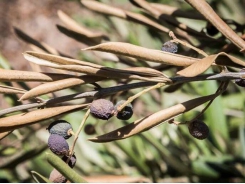Biofumigation using an eelworm trap crop

Apart from reducing cyst eelworm, planting trap crops has other advantages.
Oil radish, a popular and effective trap crop, being chopped up, as required.
Select the crop very carefully. Even with a variety deemed suitable for use as a trap crop, there are differences in effectiveness between varieties. In the past, some varieties could reduce the cyst eelworm population by up to 60%, but many modern ones offer a reduction of 80% or more. These are grouped into two categories according to the degree of effectiveness: Class 1 and Class 2.
A client of mine mentioned that sections of his oil radish crop were not growing as well as others, and that these sections coincided with the areas with a higher eelworm infestation in the previous crop. He wanted to know if the trap crop was actually working.
I explained that this was to be expected, as the eelworms still enter the trap crop, but cannot breed. The females are unable to develop the giant cells that provide 40 times more nutrition and which are necessary for egg production. The fact that the trap crop was affected like this meant it was doing a fine job and the roots were teeming with larvae.
Many trap crop varieties are effective for other eelworm species. But the wrong variety can increase the eelworm population. Discuss this possibility with the company selling trap crop seed. When cyst eelworm has been present in the soil for a time, it is likely that the number of other eelworm species will be limited. This is because the chemical measures adopted to reduce cyst eelworm populations could be an ‘overkill’ for other eelworm species.
Why nitrogen?
Instructions supplied with the seed usually recommend adding nitrogen to the crop during growth. There are various reasons for this:
- Nitrogen ensures that the crop can produce more biomass as there is a correlation between above-ground growth and root growth. More root growth equates to more eelworms hatching.
- When worked into the soil, the higher nitrogen content in the biomass will result in a quicker breakdown to humus.
- With the relatively wide carbon nitrogen ratio of this crop, more nitrogen in the residue will result in more humus being formed.
With a lower nitrogen content, more of the carbon in the crop will be lost to the soil as carbon dioxide rather than be formed into humus. As can be seen, the nitrogen will not be wasted, despite what some farmers may think.
Biofumigation
When working the crop into the soil, you get the further benefit of biofumigation. When the crop is finely chopped, an enzyme called myrosinate comes into contact with glusosinolates to form the fumigant isothiocynate. This can kill a number of soil pathogens and eelworm not attracted to the trap crop. Biofumigation occurs with cruciferous plants in general, with some being more effective than others. Oil radish and mustards are in the better class.
For the process to be effective, chop the crop up finely. Then work it into the soil almost immediately to release the gas into the soil and not the air. Next, seal it by rolling or with light irrigation to trap as much gas in the soil as possible. This process is more practical for larger operators who have specialised equipment to make it effective.
Applying a nitrogenous fertiliser at this stage will secure more humus formation and a quicker breakdown for earlier planting of the following crop. The nitrogen will not be lost but held by the soil organisms until their job is done, when it will be released for the benefit of the following crop.
Related news
Tools

Phối trộn thức ăn chăn nuôi

Pha dung dịch thủy canh

Định mức cho tôm ăn

Phối trộn phân bón NPK

Xác định tỷ lệ tôm sống

Chuyển đổi đơn vị phân bón

Xác định công suất sục khí

Chuyển đổi đơn vị tôm

Tính diện tích nhà kính

Tính thể tích ao



 Know your soil – Part 2
Know your soil – Part 2  Beat cyst eelworm with trap crops
Beat cyst eelworm with trap crops